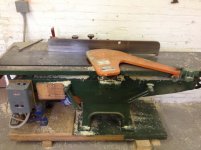Whetstone
Cast Iron
- Joined
- Mar 27, 2011
- Location
- Providence RI
I have been thinking about this for a bit, what is the best ratio of bed length to board? I have been jointing a lot of 8-12 boards for table tops recently and have been getting a concavity in the edge, maybe 1/8-" over 12 feet. I end up cleaning them up with a hand pane and they glue up fine. 4 foot boards come out straight right off the jointer and need no clean up for gluing.
The Jointer I am using is a older 12" Crescent and has (in my mind) short in-feed and out feed tables. This leads me to believe that bed length has a direct relation to how straight you can get a long board. thoughts?
I have a project coming up where I will be gluing up 10 tops that are 4' x 12' and about 30 smaller sized ones. I am thinking of investing in a larger and nicer jointer and wanted to know what this collective knowledge thought about longer bed jointers. my Crescent is works but the short bed and lack of dust collection have me searching for more.
The Jointer I am using is a older 12" Crescent and has (in my mind) short in-feed and out feed tables. This leads me to believe that bed length has a direct relation to how straight you can get a long board. thoughts?
I have a project coming up where I will be gluing up 10 tops that are 4' x 12' and about 30 smaller sized ones. I am thinking of investing in a larger and nicer jointer and wanted to know what this collective knowledge thought about longer bed jointers. my Crescent is works but the short bed and lack of dust collection have me searching for more.




